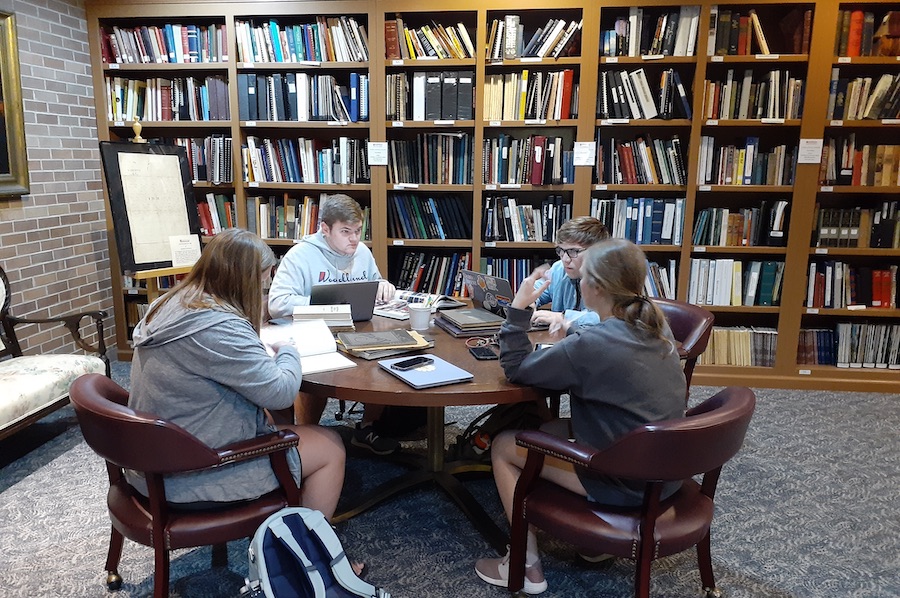Students taking the Foundations of Education class in the Anderson University College of Education are gaining insight not only on where we’ve been as a society, but also where we’re going.
Education Professor Dr. Tanya Cordoba took her students to the Anderson County Museum as part of their course’s history unit. At the museum they were asked to examine the exhibits and find something that applied to the timeline they were working on.
The College of Education wants to build partnerships with community organizations, and the museum was enthusiastic about the Anderson University students’ interest in their collections and resources. The visit also sparked inspiration among the students. This got Cordoba thinking about how history could become relevant in meaningful ways to them. She also considered how a partnership between the College of Education and the Anderson County Museum could be mutually beneficial.
This partnership is becoming a reality as students visit the museum, this time to go beyond the public-facing exhibits, diving into the archives for details that bring local history to life. The students presented their findings at a symposium that the College of Education hosted November 16 at the Anderson County Museum.
“This inquiry project takes a course that has traditionally been a very broad survey of education policy and history and provides space for students across disciplinary specialties to explore topics that matter to them as future teachers,” Dr. Cordoba said. “They are doing the research and uncovering links between past and present versus me just telling them how contemporary issues in education are actually part of a larger historical conversation.”
One group is taking on research on the change of gender norms in local education across generations. For another group, a wooden paddle was a conversation starter, leading them into records of school board meetings where corporal punishment was discussed. Another group has been looking at school yearbooks—particularly at how “Senior Superlatives” have changed over time.
“With the superlatives, we found out they were more surface-level and definitely based on appearances… ‘prettiest’ or ‘cutest’,” said student Mary Wood. Past superlatives of “best looking” or “best smile” later gave way to newer superlatives like “most likely to be a NASA engineer.”
School clubs have transitioned as well. While areas like homemaking might have been important more than 50 years ago, there are now clubs devoted to mathematics and robotics. Students also learned about clubs like the A Club and Monogram Club—a club for female students to promote leadership and physical fitness. Also, two groups are grappling with desegregation, a hot topic 60 years ago, yet as far back as the 1940s there was some interracial participation found in athletics and some African American coaches.
A student group researching athletics found it interesting that fundraisers were a big deal and often essential for a team to compete.
Student Hagan Wilson, who is also a member of the Trojans Women’s Cross Country Team, noted that a candy store was set up in a school basement to raise money for the girls basketball team to travel in 1929.
“Since they were able to travel, they actually won state that year,” Wilson said. The group also sensed that sports played a larger role in the lives of earlier generations of students and that there were some sports, such as field hockey, that don’t exist today at local schools.
Also part of the student team is Brody Bruce, who also coaches junior varsity basketball at Wren High School. Bruce remarked, “Everybody played something growing up, especially then.” Researching letterman sweaters, student Camden Hayes noted that the sweaters weren’t necessarily given out only for athletics, but also academics. He added that over time the felt letter became smaller and moved from the center of the sweater to the top corner.
As the students explore these areas, Dr. Cordoba queries them: “Why is this a hot topic for you? Why do you care?” Most importantly, rather than assigning topics to students, they got to choose a topic. She also gave them flexibility for their presentation platforms. One group may do a “TED Talk” type presentation on a stage, while another group may produce a documentary.
“For us educators, this is an authentic assessment; you’re creating something for a real audience; it’s not just for your professor,” Dr. Cordoba said, adding that the museum has been an incredible partner providing valuable assistance in the archives.
“The collaborative aspect of project based learning is also an important learning opportunity for our students as community members and future teachers who are gaining leadership skills and developing responsibility as group members,” Cordoba said.

